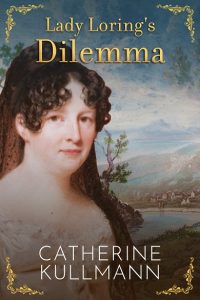Writing Historical Fiction: Catherine Kullmann
 With history becoming more and more of a niche subject at schools and universities, it is historical fiction that offers millions of readers a connection to the past, a past which casts long shadows. The first quarter of the nineteenth century – the extended Regency era – was one of the most significant periods of European and American history, a time whose events still resonate after two hundred years. The Act of Union between Great Britain and Ireland of 1800, the Anglo-American war of 1812 and the final defeat of Napoleon at the Battle of Waterloo in 1815 all still shape our modern world.
With history becoming more and more of a niche subject at schools and universities, it is historical fiction that offers millions of readers a connection to the past, a past which casts long shadows. The first quarter of the nineteenth century – the extended Regency era – was one of the most significant periods of European and American history, a time whose events still resonate after two hundred years. The Act of Union between Great Britain and Ireland of 1800, the Anglo-American war of 1812 and the final defeat of Napoleon at the Battle of Waterloo in 1815 all still shape our modern world.
But the aristocracy-led society that drove these events was already under attack from those who saw the need for social and political reform, while the industrial revolution saw the beginning of the transfer of wealth and ultimately power to those who knew how to exploit the new technologies.
It was still a patriarchal world where women had few or no rights but they lived and loved and died, making the best lives they could for themselves and their families, often with their husbands away for years with the army or at sea. And they began to raise their voices, demanding equality and emancipation. This is the backdrop for my Regency novels.
My novels are pure fiction, neither fictionalised biography nor fictionalised history. I create my characters and develop a plot just as authors of contemporary fiction do, but I must always be conscious of the constraints imposed by the historical setting. My writing process consists therefore of two entwined strands, the historical research and the fictional narrative.
First comes the research. Over the years I have built up a considerable research library as well as an extensive online library of historical facts and trivia, both of which I draw on constantly. Once I have an idea of the characters and plot of a new book, I create a public timeline for the year(s) in which it is set. Everything goes in there—the date of Easter, when Parliament is sitting, the dates of the Queen’s drawing-rooms, what is on in the theatres, what new books were published, any major public events, notorious scandals, etc. etc. I add continuously to this as I discover new information. Next, if there is any event or setting that I am not very familiar with, I dig deeper, looking in particular for Regency or Georgian sources to ensure authenticity. For example, my latest book, Lady Loring’s Dilemma, starts in Harrogate, Yorkshire, 1814 and the protagonists later travel to France where the Emperor Napoleon has been defeated and exiled to Elba, and the Bourbon monarchy has been restored, with Louis XVIII as King. Guidebooks to Harrogate and the surrounding area gave me a picture of pre-Victorian Harrogate while contemporary travel accounts such as the anonymous Diary of the Times of George IV provided a fascinating insight into Paris and France in 1814/15.
As Lady Loring’s Dilemma is a sequel to my previous novel, A Suggestion of Scandal, I was anxious to avoid inconsistencies and so started my character development by recapping everything I knew about the protagonists. I then expanded their back stories before starting my first draft. I don’t plot extensively in advance, but let the story emerge in this draft so as not to lose spontaneity. As it and the characters develop, I continue to research extensively; sometimes double-checking, sometimes expanding my knowledge. I make a point of saving everything interesting I come across online; if I do not use it in this book, I’ll have it to hand for another.
Fortunately the Georgians were great writers and there is a wealth of contemporary publications, including essays, journals, letters, novels, poetry, magazines and journals. These are invaluable both for the insight into the mindset of the time and the language used. I do my best to use the vocabulary of the time. An invaluable aid here is the Online Etymology Dictionary which explains when words and phrases were first used. I also draw on contemporary illustrations of all types, e.g. paintings, engravings, caricatures, and fashion plates, to see the Regency world as my characters experience it.
As I write, I create a table, chapter by chapter, describing the internal timeline, the main protagonists, and the pivotal plot points. This helps drive the story forward, is useful later when writing a synopsis, and helps me manage dates and the passing of time. I revise and polish the first draft as I go. When I reach the end, I immediately start a full-scale revision. After that I let it lie fallow for some weeks before giving it another polish. Only then do I send it to my invaluable beta reader. Once I have taken their feedback on board, I can move on to the publishing phase.
I have always enjoyed writing, I love the fall of words, the shaping of an expressive phrase, the satisfaction when a sentence conveys my meaning exactly. I enjoy plotting and revel in the challenge of evoking a historic era for characters who behave authentically in their period while making their actions and decisions plausible and sympathetic to a modern reader. In addition, I am fanatical about language, especially using the right language as it would have been used during the period about which I am writing. But rewarding as all this craft is, there is nothing to match the moment when a book takes flight, when your characters suddenly determine the route of their journey.
© Catherine Kullmann May 2022
—
Catherine Kullmann was born and educated in Dublin. Following a three-year courtship conducted mostly by letter, she moved to Germany where she lived for twenty-five years before returning to Ireland. She has worked in the Irish and New Zealand public services and in the private sector. Widowed, she has three adult sons and two grandchildren.
Catherine has always been interested in the extended Regency period, a time when the foundations of our modern world were laid. She loves writing and is particularly interested in what happens after the first happy end—how life goes on for the protagonists and sometimes catches up with them. Her books are set against a background of the offstage, Napoleonic wars and consider in particular the situation of women trapped in a patriarchal society.
She is the author of The Murmur of Masks, Perception & Illusion, A Suggestion of Scandal, The Duke’s Regret, The Potential for Love , A Comfortable Alliance and Lady Loring’s Dilemma
Catherine also blogs about historical facts and trivia related to this era. You can find out more about her books and read her blog (My Scrap Album) at her website You can contact her via her Facebook page or on Twitter
LADY LORING’S DILEMMA
 Must she pay indefinitely for her indiscretion?
Must she pay indefinitely for her indiscretion?
England, 1814
Delia, Lady Loring has long accepted that a wife has few legal rights and little say in the direction of her life. When she is caught in compromising circumstances, her furious husband, Sir Edward, banishes her to Harrogate where she is to live quietly with her mother and behave at all times in a seemly manner. All contact with their sixteen-year-old daughter, Chloe is forbidden.
In Harrogate, she finds small joys, makes friends and rediscovers a long-forgotten freedom. Most important of all, she meets Lord Stephen FitzCharles, her first love of some twenty years ago. The separation from Chloe grieves her, and she worries about what will become of her daughter but a mother has only the rights her husband allows her and Sir Edward shows no sign of relenting.
Delia resolves to place her trust in Stephen who offers her a new life on the Continent. They leave for Paris, then travel on to Nice. But Sir Edward, determined that his erring wife pays for her misdeeds, counters with new measures.
Napoleon’s escape from Elba and march on Paris to oust the newly-restored French king, bring further complications as Delia must face the most unexpected of decisions. Can she retain her freedom and reconcile fully with her daughter? Or will her wings be clipped forever?
BUY HERE
Category: On Writing































Thank you so much for hosting me.